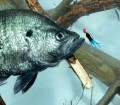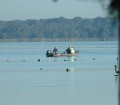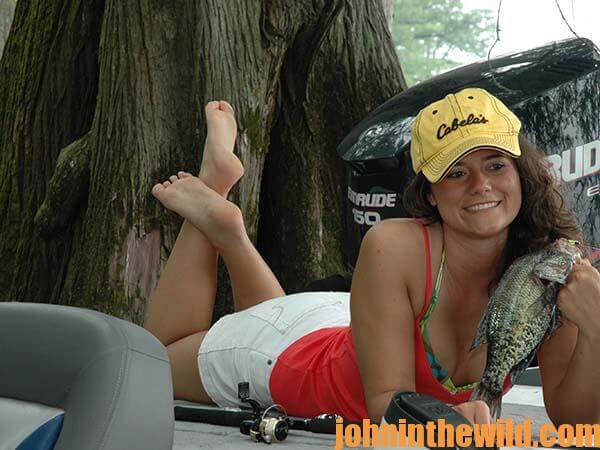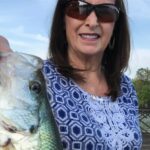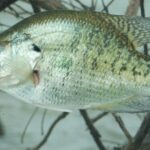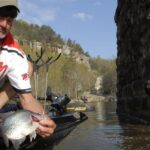John’s Note: You can catch plenty of big slab crappie all year if you know where to fish for them and what baits to use. Then when your taste buds tingle for those tasty, just popped out of the oven or frying pan fillets of crappie, you won’t have to wait until the spring spawn to catch them. Let’s take a look at the kinds of places where you can find and take crappie throughout the year.
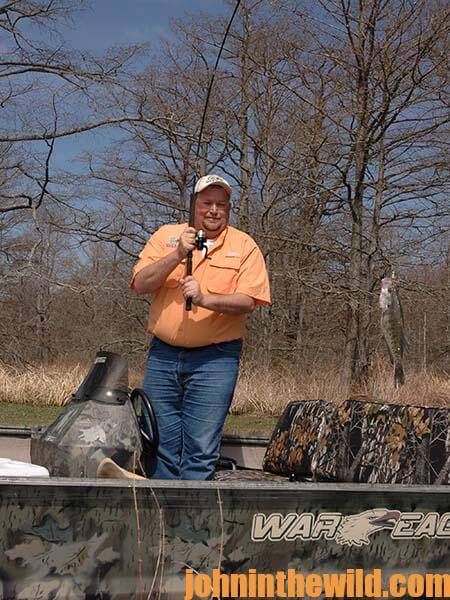 According to fisheries biologists, generally when the female crappie go to the bank to spawn, they only may remain on the bank for an hour or two, spawning out perhaps 20 percent of their eggs.
According to fisheries biologists, generally when the female crappie go to the bank to spawn, they only may remain on the bank for an hour or two, spawning out perhaps 20 percent of their eggs.
Then these females move out into the deeper water while the males that are constantly on the bank fertilize the females’ eggs. During the spawn, one female may return to the bank three or four times, until she is spawned out. Different males fertilize her eggs. Even at the peak of the spawn, as many males and females will be in the deeper water waiting to spawn as are in the shallow water spawning. After the spawn is over, crappie will tend to move away from the shoreline and scatter out more. In many lakes, the crappie spawn usually occurs in some type of embayment. After the spawn, the scattered crappie will be more in the middle of the embayment than along the edges. To catch post-spawn crappie, anglers who drift fish live bait or trolling jigs may catch as many, if not more, crappie than the anglers who are fishing sunken brush, ledges and other bottom drop offs.
With the crappie scattered over a much-greater area immediately after the spawn, the more water you can cover trolling, the more crappie you can catch.
Also, because crappie will hold between the creek channel and the bank, anglers accomplished in the art of trolling can move their boats up and down the water between the bank and the creek channel, cover a large region and often take plenty of crappie.
Also drift fish either minnows or jigs at this time of year for success. Since crappie will remain in an embayment right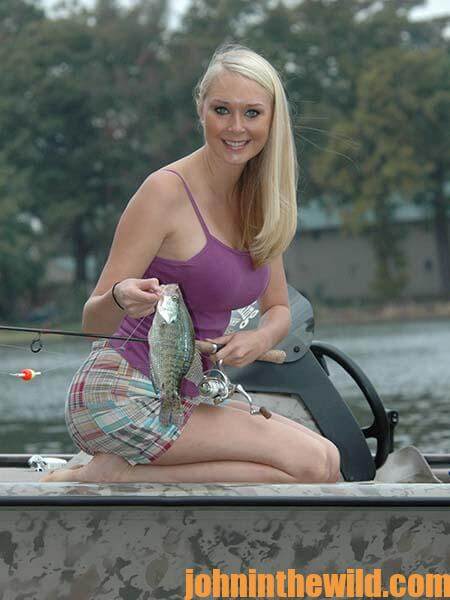 after the spawn means, even though no creek or river channel runs close to the spawning flat, anglers more than likely will catch crappie trolling and drift fishing in the middles of sloughs and bays.
after the spawn means, even though no creek or river channel runs close to the spawning flat, anglers more than likely will catch crappie trolling and drift fishing in the middles of sloughs and bays.
Post-spawn crappie primarily will rove. If you catch a good number of crappie on a drop off, a ledge or brush, and the fish stop biting, a new group of crappie may move into that same cover within an hour or two or on the next day. Or, you may locate a good bunch of crappie on a spot one day but get no bites when you return there the next day.
“Although from the spawning area the bottom may drop two or three times before it slopes off into the creek channel, post-spawn crappie usually will concentrate on that very-first drop on whatever cover is available on that bottom break,” Roger Jarvis of Nashville, Tennessee, a longtime, avid crappie fisherman, explains. “Water clarity dictates which method of fishing I’ll use. If the water is extremely clear, then I’ll back away from the structure and pitch jigs to the ledges or drop-offs. But if the water is stained, I’ll vertical jig right on top of the structure down to it.”
 To learn more about crappie and how to fish for them from the masters of the sport, get “Crappie: How to Catch Them Spring and Summer” and “Reelfoot Lake: How to Fish for Crappie, Bass, Bluegills and Catfish & Hunt for Ducks.” Click here to get these books.
To learn more about crappie and how to fish for them from the masters of the sport, get “Crappie: How to Catch Them Spring and Summer” and “Reelfoot Lake: How to Fish for Crappie, Bass, Bluegills and Catfish & Hunt for Ducks.” Click here to get these books.
About the Author
John Phillips, winner of the 2012 Homer Circle Fishing Award for outstanding fishing writer by the American Sportfishing Association (AMA) and the Professional Outdoor Media Association (POMA), the 2008 Crossbow Communicator of the year and the 2007 Legendary Communicator chosen for induction into the National Fresh Water Hall of Fame, is a freelance writer (over 6,000 magazine articles for about 100 magazines and several thousand newspaper columns published), magazine editor, photographer for print media as well as industry catalogues (over 25,000 photos published), lecturer, outdoor consultant, marketing consultant, book author and daily internet content provider with an overview of the outdoors.

